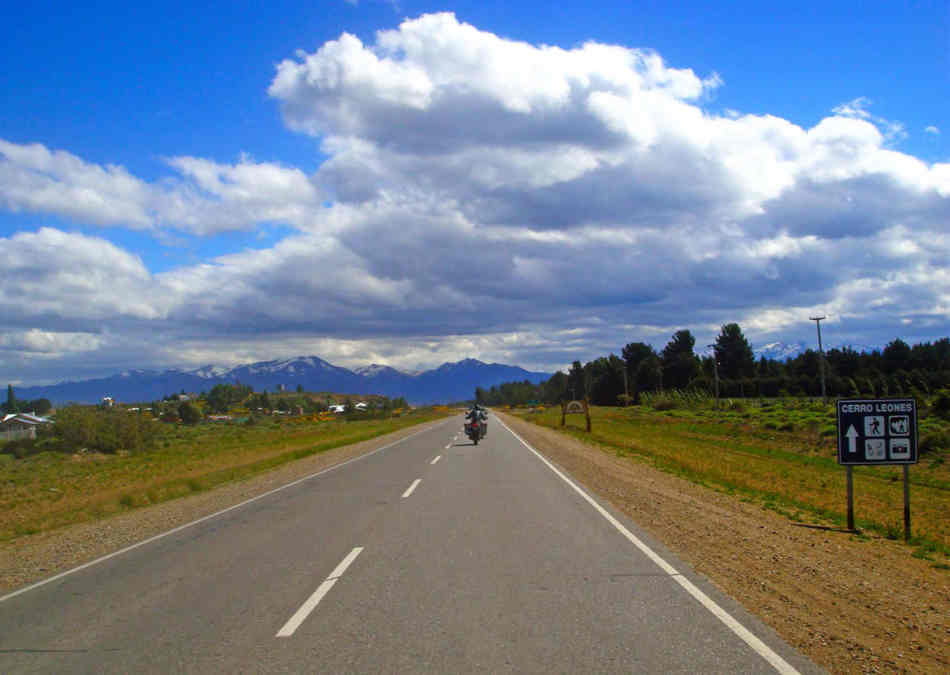
The border crossing between Chile and Argentina at Portezulo de Puyehue is the last paved crossing for several thousand kilometres. As the border is high in the mountains the arrangement the authorities from each country have made are quite clever. Rather than having two border crossings back to back on the top of a snow capped mountain the Chileans take one side and the Argentineans the other side with a spectacular mountain pass road in between.
The road twists and turns. We leave the leafy lowlands behind and climb into the snow. After about twenty kilometres we reach a simple sign set in side of the road that reads ‘Welcome to Argentina’. A few kilometres later as we ride down the other side of the mountain we come to what looks like a ski lodge, but is in fact, the Argentinean border post. We get our passports stamped and go to the Adunas to arrange the temporary import papers for our bikes. The lady behind the counter realizes that our Spanish is less than great and simply takes back our paperwork and fills it in for us. She then gives us our copies and sends us on our way.
The first town we come to is Val de Angostura. The town is a perfect Swiss village straight out of the Alps! It even has a shop with a cigar humidor in it. As we sit outside a café on the main street I remember hearing that ‘Operation Free Flow’, the annual nightmarish attempt by Dublin’s city elders and police force to manage the Xmas traffic, has started. Some days can be tough on the road, but this is definitely not one of them. Welcome to Argentina!
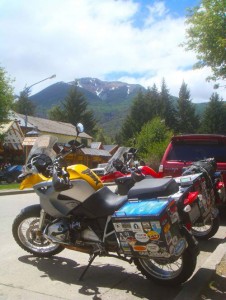 After lunch and a very fine Cuban cigar we ride on to the next big town. Bariloche is a very tourist orientated town since it’s a jump-off point for the many national parks which surround Lake Nahuel Huapi and the last big supply town for people wanting to travel further south into Patagonia.
After lunch and a very fine Cuban cigar we ride on to the next big town. Bariloche is a very tourist orientated town since it’s a jump-off point for the many national parks which surround Lake Nahuel Huapi and the last big supply town for people wanting to travel further south into Patagonia.
It’s also famous as every Argentinean chocoholic’s favourite holiday destination! The main street is lined with chocolatiers juxtaposed between souvenir shops. The town has a very European feel to it for both of us. Perhaps it’s due to Alpine buildings that remind us of Bavaria but the further one travels outside of the main tourist drag, the timber style cottages and shops give way to low rise apartments and tacky new developments. This seems to be the negative side to the huge income provided by tourists.
It’s quite chilly here, cold winds blow down from the Andes and in off the lake. We find a nice B&B and as Maeve is feeling a little under the weather, we decide to stay for a few days. While unpacking our luggage, Maeve notices that the metal bracket on the left hand side of her bike has sheered. During the accident back in Colombia, although she was hit on the left, she landed heavily on her right side. The panniers took most of the impact, and the support bracket holding it to the bike’s frame was bent. The guys in Medellin did their best to straighten it out but it was never going to be like new. Sometime over the last few days the vibration and constant movement of the motorcycle combined with the weight in the pannier have caused this weak point to fail.
A few options are looked at but the best we can do right now with what we have to hand is to splice the two pieces together where they have sheered with two flat pieces of metal and hold the whole thing in place with a few jerry rigged bolts. We will have to find someone who knows how to weld soon but for the time being it should take a little of the movement out of the box.
If you’ve already heard about Ruta 40 in Argentina you’ll have a pretty good guess as to how this story is going to go! For those who haven’t, it’s one of those legendary motorcycle roads, isolated, scenic and not yet paved, with very little traffic or signs of the outside world. It’s tough, exhausting and hard on both the motorcycles and the riders. However, some sections of the road are now paved and as we ride south there are constant signs that soon all of it will be.
The northern section is paved and after leaving Bariloche, we take Ruta 258 south. It was on this stretch of road that our ‘new’ bikes rolled over 40,000 kilometres, hard to believe we’ve only owned them for seven months! Lunch is in the small agricultural town of El Bolson, where I have empanadas, a type of deep fried wrap containing mince. We decide to take things easy for the first day as we both knew that the following few are likely to be strenuous.
A further 100km or so south of El Bolson, we join a beautifully paved section of Ruta 40. After crossing the Andes a few days previously there had been a noticeable change in temperature. The further south we go the colder and windier it gets. We have to contend with cross winds that can pull a fully loaded 1200GS from one side of the road to the other requiring our full concentration and it’s quite exhausting!
We still have over two hundred kilometres to cover before we reach our stop for the night. The landscape is flat. The wind has been blowing here for so long that the little vegetation there is here is only a few inches tall. There is little or
no evidence of humans, simply a bleak and isolated beauty.
Eventually we bully our bikes into Gobernador Costa, a small refuge in the windy desert expanse. The town just about has all the required facilities a tired traveller could want. We found a small hostel and rested up for the night.
We were lucky enough to get a small private room in the grounds of the hostel campus. The room was built of blocks with a flat tarred roof, rather like a residential car garage, and about the same size. It was furnished with a small double bed, some chairs and there was a toilet and shower room to the rear.
We were both exhausted from the day’s ride, but I more so. I also felt very cold and took one of our sleeping bags from the bike to wrap myself in before I fell into a deep sleep. Some time later I woke up with severe pains in my stomach. I felt as though I was being cut from the inside when I felt what seemed like a bubble move in my gut. I jumped up and ran, doubled up, to the toilet and just made it before my bowels violently evacuated themselves.
As we traveled we both got stomach bugs from time to time and very often it was just a matter of getting used to the local cuisine. But this was different. I’m standing looking at my reflection in the mirror, washing my face and hands when without warning my stomach does a roll and I vomit suddenly, noisily and powerfully into the sink. I run the water and start to wash again when I notice how clammy I feel. My skin is grey and I’m covered in a cold sweat. Then before I had time to think the pain started in my stomach again and it was back to the toilet. No sooner had I finished and it was time to vomit again.
This seemed to go on for an eternity. I was starting to seriously worry, never mind the runs, I was still puking like a burst pressure hose and wondered if I would rupture something. Then it happened again, this time I didn’t get my mouth opened quick enough and I almost laughed as a small, un-chewed piece of mince from the empanada that I’d had for lunch shot violently out of my nose and hit the mirror. Eventually it stopped and I cleaned the bathroom from top to bottom (pardon the pun), while Maeve got some sleep.
The following morning I’d taken a heap of medication and felt a little dryer so we set out for Rio Mayo, and although cold, the winds were a little less than the previous day. Thirty or so kilometres south of Gobernador Costa, there is a “Y” junction – one leading onto an unpaved Ruta 40 going south west, the other a paved Ruta 20. Since I still feel really weak, I don’t want to be in a position where I have to pick up a dropped bike, we opt to continue on Ruta 20 and follow the paved road. We can always link back onto Ruta 40 further south.
Our lunch time stop and fuel stop is Rio Mayo – here we rejoin Ruta 40 in earnest, so no more blacktop. We pay a visit to the local bank, changing some of our Chilean currency for Argentinean pesos, as the ATM won’t accept our cards and we don’t know when we’ll next get a chance to get more cash.
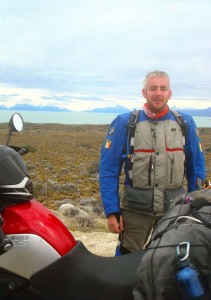 We meet up again with the ghosts of Butch and Sundance who were said to have spent some time in this part of the world, they were wrongly blamed for holding up the bank we’re in and they left the neighbourhood in a hurry before the posse came looking for them. Nowadays security is pretty tight in these isolated banks and hawk like security guards watch us during our transactions.
We meet up again with the ghosts of Butch and Sundance who were said to have spent some time in this part of the world, they were wrongly blamed for holding up the bank we’re in and they left the neighbourhood in a hurry before the posse came looking for them. Nowadays security is pretty tight in these isolated banks and hawk like security guards watch us during our transactions.
We fill our bikes and the lady in the petrol station warns us to go slow, the road south is dangerous and tough. How right she is! Initially the going is very difficult, sand, gravel and rocks the size of a fist, in places a couple of inches deep. One hundred and twenty grueling, stony, sandy kilometres later and we hit paved Ruta 43 for about thirty kilometres into Perito Moreno.
 Tired, hungry and feeling more than a little dehydrated, we arrive in the small town. Here we find all the basic services we need. We end up spending two nights here, exhausted from the previous few days riding. We both needed the break before setting out on the really long stretch which lay in front of us, almost 500 kilometres of rough gravel road to Trés Lagos with an intermediate stop in Bajo Caracoles
Tired, hungry and feeling more than a little dehydrated, we arrive in the small town. Here we find all the basic services we need. We end up spending two nights here, exhausted from the previous few days riding. We both needed the break before setting out on the really long stretch which lay in front of us, almost 500 kilometres of rough gravel road to Trés Lagos with an intermediate stop in Bajo Caracoles
for fuel.
After our day off we set out early from Perito Moreno and have the most wonderful breakfast surprise as we leave the town, a brand spanking new paved road for an unbelievable fifty kilometres. It was such an easy way to start
the day.
Unfortunately it ends abruptly and we are back to the now familiar gravel track. Although the road is wide enough for two large vehicles to pass, in most places there is just one track, left by one of the 4WD vehicles that take eager tourists across the barren landscape. These trucks push the gravel between their wheels and to the outside of the track. This leaves us with two narrow trails to follow, in places just a few inches wide, in others as much as a few feet.
Either side of the track lies deep unforgiving gravel and when the wind picks up, and causes the motorcycles to start weaving, it’s just a whole lot of fun! We spend most of the morning negotiating this and eventually wind our way across the bleak landscape to Bajo Caracoles.
It is extraordinarily tiring but the landscape is beautiful. The sheer size of the place is breathtaking and we learn that the winds coming off the South Pacific and the South Atlantic meet on the southern tip of the Americas and blow across and up the tip of the continent. This explains the consistency, strength and temperature of it.
There is constant evidence that the gravel Ruta 40 will soon be no more – from the abrupt end of the paved surface outside Perito Moreno to Bajo Caracoles and further south there are new wide flat tracks, in places ready to receive the first coat of tarmac. This new road appears tantalizingly beside the old trail, straightens out the bends and has new bridges to cross the dry riverbeds. We pass workmen and their heavy vehicles.
Bajo Caracoles is a small huddled settlement of a few houses, a small hotel and a police station. We refuel and learn that it is 340km to Trés Lagos, the next fuel stop and our intended stop for the night. A cup of tea and some Argentinean Cadbury’s chocolate later and we are ready for the next stage! It was just after nine in the morning when we left Perito Moreno, but the trail was much more difficult than the previous day and we made less progress than we expected. By seven in the evening we are still over 100km from Trés Lagos and we’re getting tired, very tired. Maeve loses concentration for a second and before we know it she’s lying on the ground knee deep in gravel!
She reckons autopilot kicked in when she felt that she was going a little too fast and squeezed the front break to take off some speed. Her front mudguard is now sporting some gravel rash, but apart from that everything is fine.
We continue and about twenty kilometres further along we come to a small farm with a camping and hotel sign where we opt to stop for the night. The wonderful ladies who run the farm welcome us warmly and tell us we can leave the motorbikes in the shed. We ride our bikes in to what seems like an ordinary farm shed and I am immediately struck by the smell. Maeve jumps off her bike and walks over to a large pen against one of the side walls.
Looking over she sees not goat kids as she expected, but llama kids. Four of them are curious and anxious at the same time when they see her, unsure whether she’s a threat or bringing the milk. I join her to find eight big dark eyes peer up at us from under their long lashes.
The ladies of the house cook us a warm meal and make sure we have everything we need. It’s a wonderful self sufficient farm on the shores of Lago Cardiel. After dinner we sit outside in the chill Patagonian wind and watch the sun set over the desert hills. A truly tough day but so rewarding!
Returning for breakfast the following morning to the dining room, our host asks us with a grin on her face if we’d like some bacon, pointing to a llama standing outside. Fearful of where exactly the meat would come from, I decline the offer.
Packed up, we move on again and make the next 90km to Trés Lagos in about an hour and a half. Just over the bridge into the town we spot a sign for fuel and, amazingly, blacktop! Our maps indicate more gravel trail for another 130km until we reached a paved Ruta 5, could it really be paved all the way to Ruta 5?
In the petrol station we refuel and I ask the cashier about the road ahead. Yes, she says, it was mostly paved recently, except for a little bit. I really should have asked what exactly a “little bit” meant! We ride over 50km of new paved road and some of the most wonderful scenery before we hit the gravel again!
South of Trés Lagos the road skirts Lago Viedma, full of milky turquoise glacial water and Parque Nacional Los Glaciers behind it. Rio Leona carries the milky blue water all the way from Lago Argentina and the road follows it. And just as suddenly as it started the gravel stops and we’re back onto paved blacktop again. At this stage I won’t let myself believe it will last all the way to Ruta 5 but miraculously it does! Late in the afternoon we roll into El Calafate, a town that plays host to all the tourists who travel here to visit the Moreno Glacier. We’re just glad to be back to some kind of civilisation. We have a choice of restaurants and hostels; there is even the extravagance of ice-cream! Later that night we are heading back to our lodgings when we look up at the sky. It’s as if some celestial being has tipped a bucket of stars across it and I understand what Dan Walsh meant when he described the night sky in the Sahara as being so full of stars that there was no room for the black.
The cold, cold wind travels up with the Humboldt Current from the Antarctic into the Pacific Ocean. It then crosses the archipelago of islands that make up southern Chile and hits the mountains in the southern Andes. It crosses over these snow-capped giants and blows down into the Patagonian Steppe in Argentina and slams its icy unpleasantness into the side of my bike. If you had told me that your bike had got caught in a cross wind and carried you across the road into the hard shoulder on the far side of the street I would have laughed at you and asked if you had reconsidered riding a bike. This, however, is Patagonia and not Kildare (although the similarities are disturbing) and that’s exactly what happened to me as we rode from the town of El Calafate to the infamous Moreno Glacier.
About 50km outside the town the Argentine government has set up a park, the Los Glaciares National Park, within which is the Glacier itself and while the total journey is only 75km in all, it’s a miserable one. If you’ve seen the movie ‘March of the Penguins’ you may be able to understand just how miserable this cold, windy journey is. Remember the penguins egg cracking at the eleventh hour and you’ll begin to understand how I feel. I’ve seen glaciers in Alaska; can this one really be worth it?
This one is a little bit different, however. This ice formation is 30km long and covers an area of over two hundred and fifty square kilometres. The glacier is part of the Southern Patagonian Ice Field located in the Andes on the border with Chile. It is the world’s third largest reserve of fresh water.
The Perito Moreno Glacier is one of only three Patagonian glaciers that are not retreating. Periodically the glacier advances over the L-shaped Lago Argentino forming a natural dam which separates the two halves of the lake when it reaches the opposite shore. With no escape route, the water-level on the Brazo Rico side of the lake can rise by up to 30m above the level of the main lake. The enormous pressure produced by this mass of water finally breaks the ice barrier holding it back, in a spectacular rupture event.
 The Moreno Glacier is arrow shaped and as much as 5km wide at the lake end, with an average height of 60m above the surface of the water, with a total ice depth of one 150m. It advances at a speed of up to 2m a day, although it loses ice at the same rate from its leading edge, meaning that aside from small variations, its front end has not advanced or fallen back in the past ninety years since it was discovered by Snr Moreno. Further back up the mountain at its deepest part, the glacier has a depth of approximately 700m.
The Moreno Glacier is arrow shaped and as much as 5km wide at the lake end, with an average height of 60m above the surface of the water, with a total ice depth of one 150m. It advances at a speed of up to 2m a day, although it loses ice at the same rate from its leading edge, meaning that aside from small variations, its front end has not advanced or fallen back in the past ninety years since it was discovered by Snr Moreno. Further back up the mountain at its deepest part, the glacier has a depth of approximately 700m.
Now deep in the park we are on a twisty gravel road. To our right is the lake and to our left the mountainside. As we round a corner and the wind slams hard into the side of the bike. I swear and push hard on the bars – if I found this enjoyable I’d become a sailor! I look up and there it is. A huge sheet of ice. It looks like someone has spilled a can of perfection at the top of the mountain and it has flowed down to the lake covering everything in its path with its deep icy blue beauty. I pull the bike over to the side of the road. The wind and the cold are completely forgotten, all the hype in the tourist brochures couldn’t have prepared anyone for this. I just sit there in awe of the beauty of this stunning natural masterpiece. The glacier straddles the width of the lake and has sealed off one side, which is milky white sediment that makes the water this brilliant turquoise colour. Because the ice is so compacted the glacier is much more blue than white and the snow-capped mountains with the sun in the background frame everything perfectly.
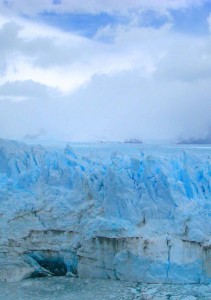 We ride on to a grove of trees and park up our bikes before boarding one of the park service’s buses and getting a lift up to the viewing platform. The place is teeming with tourists from all over the world. There is a café, a restaurant and lots of information about the glacier and the surrounding environment. We take a walk down to the viewing deck to get a few pictures and as we get closer we can hear what sounds like thunder. As we get to the water’s edge we are just in time to see a huge chunk of ice break off the face of the glacier. The block is well over twice the height of my house and watching it break away is like seeing a ship sink, a building collapse and a land slide happen all at once.
We ride on to a grove of trees and park up our bikes before boarding one of the park service’s buses and getting a lift up to the viewing platform. The place is teeming with tourists from all over the world. There is a café, a restaurant and lots of information about the glacier and the surrounding environment. We take a walk down to the viewing deck to get a few pictures and as we get closer we can hear what sounds like thunder. As we get to the water’s edge we are just in time to see a huge chunk of ice break off the face of the glacier. The block is well over twice the height of my house and watching it break away is like seeing a ship sink, a building collapse and a land slide happen all at once.
We stay for a while taking pictures and watching smaller breaks before retreating to the restaurant for lunch. Afterwards Maeve goes back to the bikes a few minutes before I do and when I catch up with her she is surrounded by Portuguese tourists who seem quite fascinated by this wee girl from Donegal and her big, filthy motorcycle. They form a circle behind her and I’m handed a selection of digital cameras to record the moment.
As we ride back to El Calafate the wind has dropped quite considerably and I can’t help but wonder if all the chickens in all the farmyards in Patagonia have fallen over.
We planned to cross from Argentina into Chile to visit Torres Del Paine National Park from the town of El Calafate where we had stayed for our visit to the Moreno Glacier. Unfortunately, while it is possible to cross the border here, there is no Immigration Office. Therefore it would involve a long back track all the way down to Cancha Carrerra, some 500km south of El Calafate. From here it’s across the country to the town of Esperanza, where we refuel and plan to make a 45° turn and head back across to the Chilean border point at Cancha Carrerra.
An interesting fact about oil rich Patagonia is the price of fuel here – premium grade 98 octane costs as little as 40 cent euro per litre. However the problem is that the vendors of fuel make almost no profit, therefore, while every fuel station has a café, shop and souvenir stand, many of them don’t seem too pushed on stocking any fuel. When we get to Esperanza, the gasolinera is empty and all the nozzles are tied up over the pumps to stop passing motorists from trying to use them. We are now faced with a dilemma: take a chance on making it to Cancha Carrerra, return to El Calafate or change our plans completely and continue to the Atlantic coast and the town of Rio Gallegos.
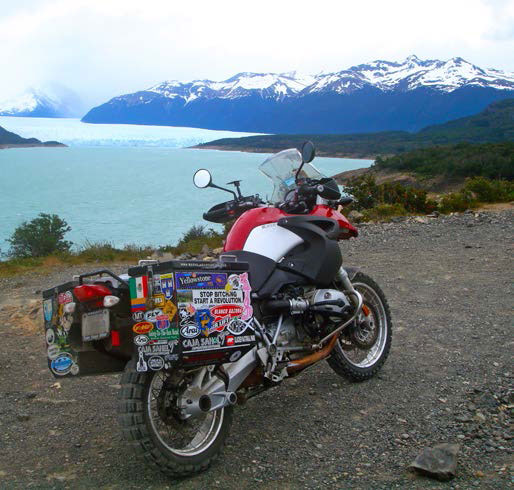 We stop at the excellent restaurant and have a great lunch of Spanish tortilla while we make our decision. Our waiter, a friendly chap is unable to help us. It remains unclear where the next petrol station is. We know we have range to reach Rio Gallegos but it still remains unclear whether we can make it back to Chile. To make matters worse the Patagonia crosswinds are as strong as ever. The only way forward is to the Atlantic Ocean. We pay for our meal and buy a ridiculously large bag of Patagonian souvenir stickers.
We stop at the excellent restaurant and have a great lunch of Spanish tortilla while we make our decision. Our waiter, a friendly chap is unable to help us. It remains unclear where the next petrol station is. We know we have range to reach Rio Gallegos but it still remains unclear whether we can make it back to Chile. To make matters worse the Patagonia crosswinds are as strong as ever. The only way forward is to the Atlantic Ocean. We pay for our meal and buy a ridiculously large bag of Patagonian souvenir stickers.
It’s back on the road, back into the crosswind and 120km later we reach the military/police checkpoint at Güer Aike. Here we both draw to a halt and there in the bitter cross wind which is now freezing cold, Maeve is asked to produce her documents, a careful note is taken of her passport number, the registration of her bike, where she is going to and coming from. Meanwhile I’m just waved through. I suppose even here in Argentina they know that trouble comes in small packets!
Paul Browne
www.pabloscafe.ie



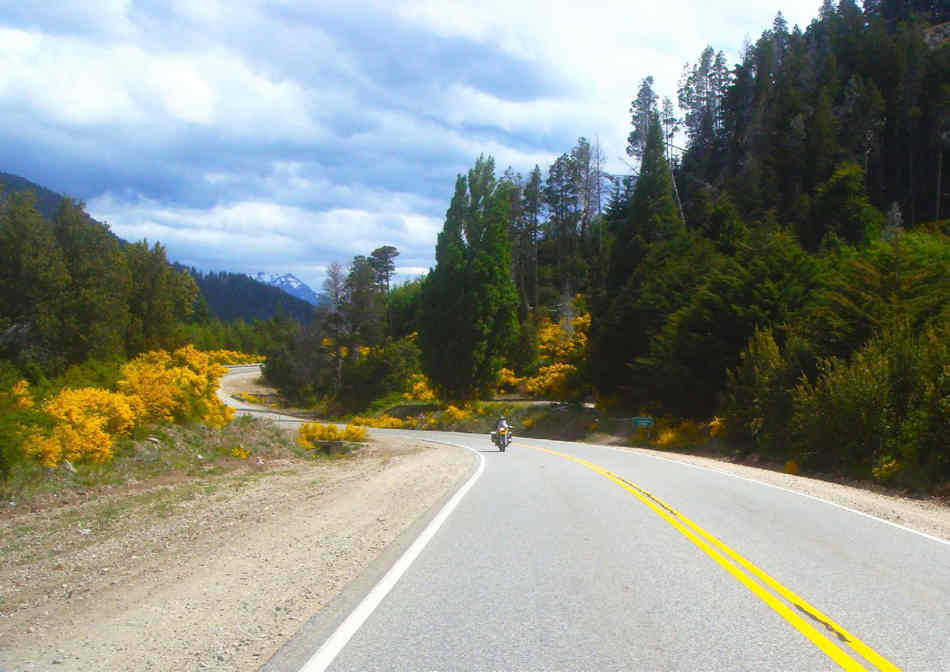
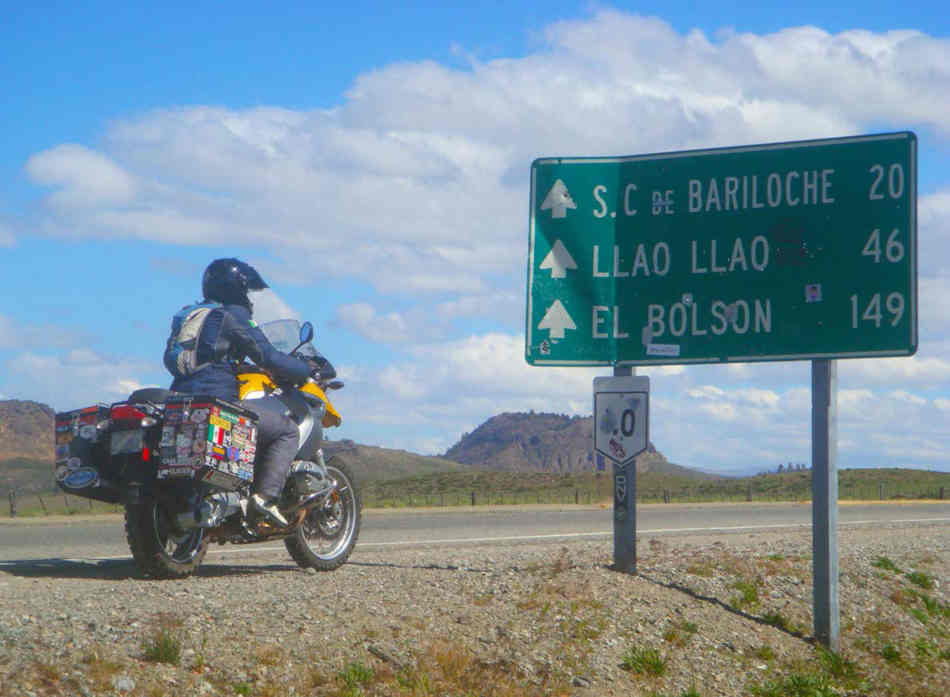


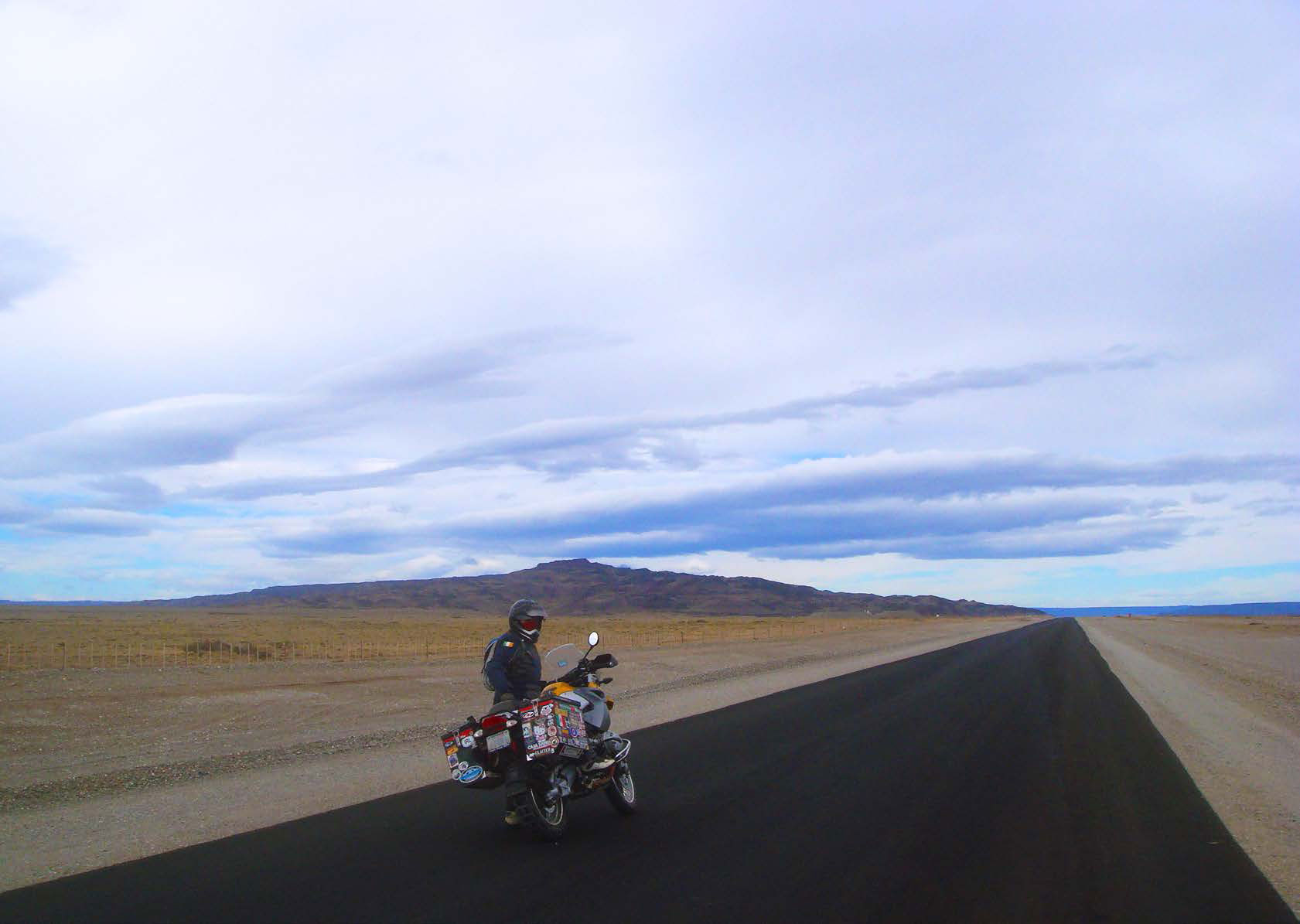
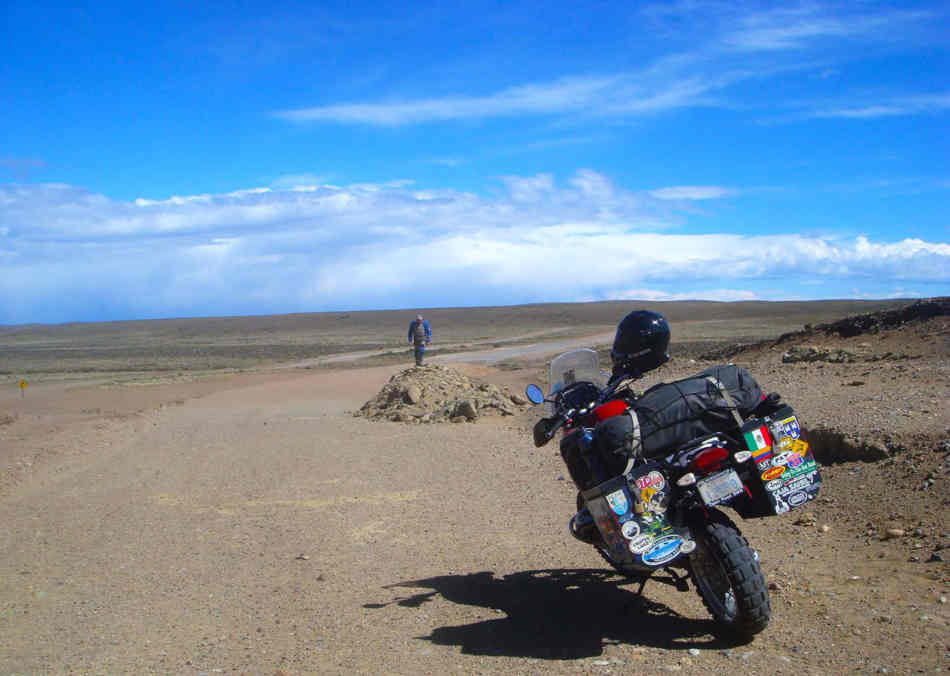

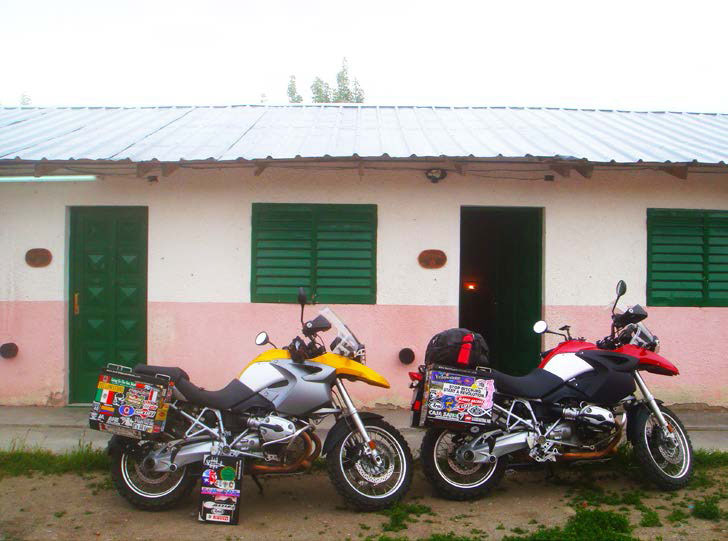
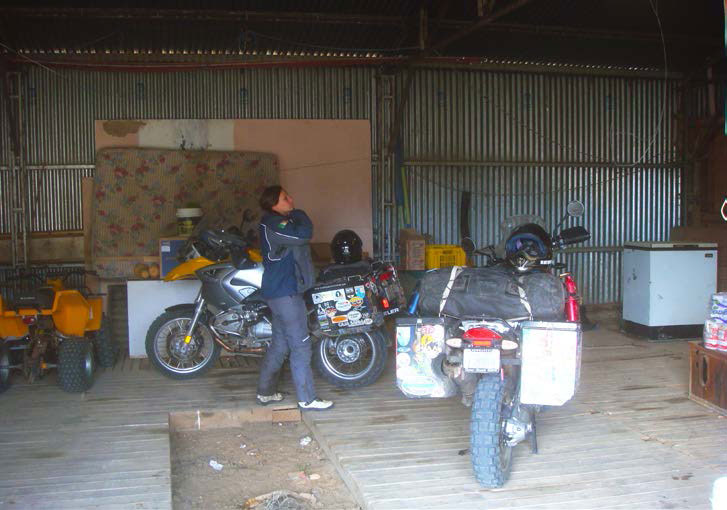

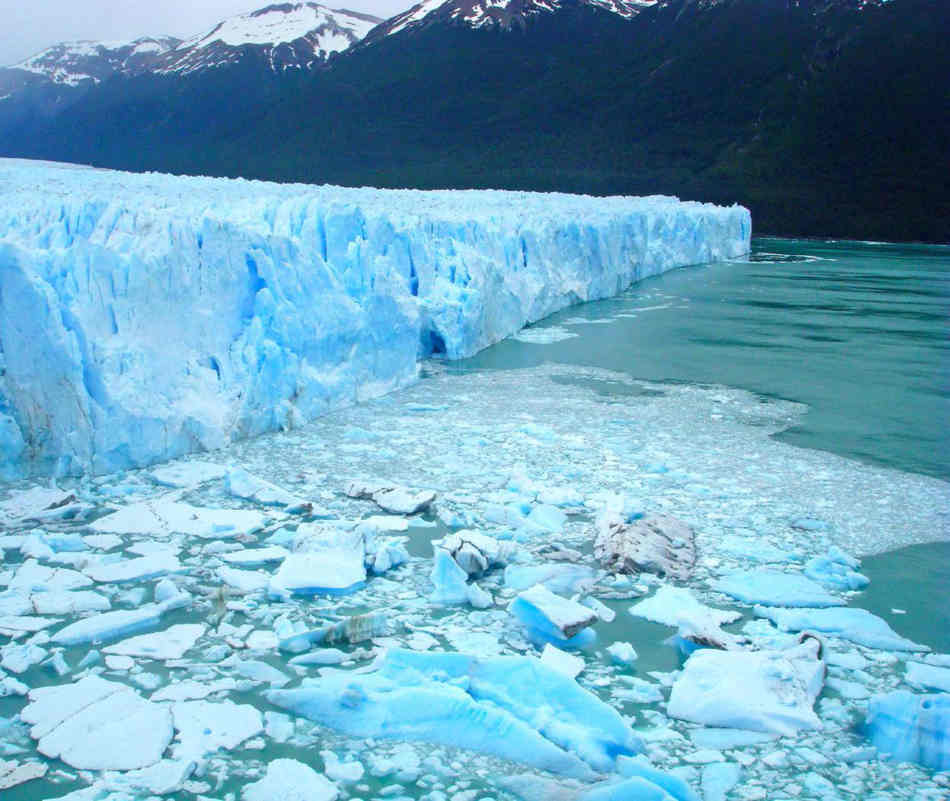
Hi, I’ve read every one of this monthly series in TRD from the start and it’s almost like being there with you. The photo’s are brilliant and the writing easy to read and well put together. I’d like to wish you all the best to the end of the journey and hope to see the whole story as a book, soon, so that I can add it to my collection which includes such lournals as “Jupiters Travels” and the “Long Way” books.
All the best
Nick
Leeds
West yorkshire